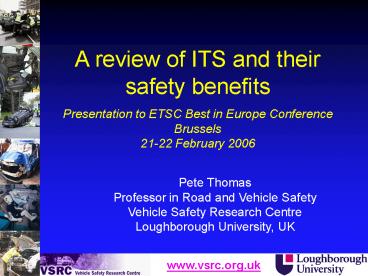Introduction to Vehicle Safety 2 PowerPoint PPT Presentation
Title: Introduction to Vehicle Safety 2
1
A review of ITS and their safety
benefits Presentation to ETSC Best in Europe
ConferenceBrussels21-22 February 2006
2
Casualty reduction
- 2010 target of 50 reduction in fatalities
- Prime purpose of ITS, eSafety and related
initiatives is to reduce casualties on the road - How can ITS functions improve casualty
reduction?
3
Where are we now?
Pre-crash Road safety driver training, road design, roads policing, vehicle performance and maintenance, belt use, helmets
Crash Crashworthiness - Restraints, structure design, biomechanics
Post-crash Rescue Paramedics training, extrication, hospital provision
4
VehiclesPrimary Safety
- Conventional vehicle dynamics braking,
handling, cockpit ergonomics etc - Primary NCAP significant differences in braking
behaviour - Vehicle performance varies significantly need
for improved minimum standards
5
VehiclesSecondary Safety
- Major improvements in crashworthiness driven by
EuroNCAP and legislation - Accident data shows a reduction in fatality rates
of drivers of 22 - Passive safety is a mature science
- Further big reductions expected from improved
compatibility, side impact performance,Pedestri
an protection
6
Learning from other transport modes
7
Aviation the safest transport mode
- Crashes are rare
- Pilots well trained and monitored
- Automatic systems reduce conflicts
- Vehicles controlled in position and speed
- Heavily controlled andregulated
8
eSafety Initiative
9
EU eSafety Initiative
- Development , deployment and use of Intelligent
Integrated Safety Systems - Information and communication technologies
- Driving technology development
- Research funding
- Enabling actions (eg waveband allocation, eCall
MoU) - Coordinating Member state support
eSafety link
10
Integrated Safety on Roads
- Strong industry led set of projects
- Provides integrated approach to active safety
- Total EU investment 250m (50)
- Specifies direction of technology development
11
Casualty reduction and eSafety
12
Accident data
- Accident data forms the foundation of road and
vehicle safety management process - Macroscopic data shows casualty trends
- In-depth data supports countermeasure development
- Continuous in-depth researchinto accident and
injury causation is needed to identifypriorities
and develop countermeasures
13
Accident Priorities
- Primary risk factors from accident data
- Speed 30 of road deaths
- Alcohol 17 of road deaths
- Seatbelt 30 of road deaths
14
eSafety Technology Roadmap
- Priority vehicle based technologies
- ESC (Electronic Stability Control)
- Blind spot monitoring
- Adaptive head lights
- Obstacle collision warning
- Lane departure warning
- Priority infrastructure based technologies
- eCall
- Extended environmental information (Extended
floating car data) - RTTI (Real-time Travel and Traffic Information)
- Dynamic traffic management
- Local danger warning
- Speed Alert
15
Prioritisation of ITS technologies
- Based on maximum casualty reduction
- Take account of
- Numbers of relevant crashes
- reduction of relevant crashes
- Confounding factors especially human factors
- No systematic estimates of casualty reduction for
ITS
16
How do we evaluate active safety systems?
- Problems
- No systematic method of assessment
- Insufficient in-depth representative data for EU
25 - Countig crashes that didnt occur (near misses,
naturalistic driving)
17
Casualty reduction methods
- Standard approaches are
- Engineering
- Enforcement
- Education
- How is ITS being used to improve these
techniques? - Many engineering measures
- No enforcement
- Little education
18
Gaps in road maps
- Intelligent Speed Adaptation
- Alcohol interlock
- Enforcementtechnologies
- Integrated approach with road safety initiatives
19
EU-level approaches to casualty reduction
- Wide range of fatality rates in EU 25
- Some countries need traditional casualty
reduction methods - Others need new methods including ITS
- Best practise is to have an integrated road and
vehicle safety management approach - There are opportunities to improve the
coordination of road and vehicle strategies at
EU-level
20
Conclusions
- There are still considerable gains available from
improved passive safety - ITS has the potential for further casualty
reduction - Countermeasures should be targeted for maximum
casualty reduction - eSafety initiatives should be properly integrated
within the wider road and vehicle safety context
21
Contact
- Pete Thomas
- Professor of Road and Vehicle Safety
- Vehicle Safety Research Centre
- Ergonomics and Safety Research Institute
- Loughborough University
- p.d.thomas_at_lboro.ac.uk
Attend the 1st SafetyNet Conference Workshop on
European Accident Data and Road and Vehicle
Safety Policy Prague May 10 - 11 2006

